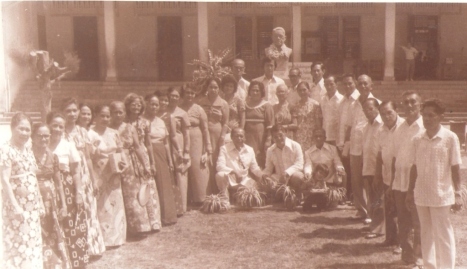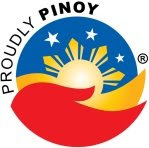Don Fortunato U. Arban
Don Fortunato U. Arban
FATHER OF RIZAL, LAGUNA
By Atty. Rogelio C. Isleta
 The last five decades of Rizal, Laguna’s existence as a municipality have seen a handful of men who invariably contributed to what the town is now; but the name of Don Fortunato U. Arban stands out among these brilliant men. His record as a political leader is yet to be surpassed and the achievements of his administration, yet to be equalled to those who succeded him.
The last five decades of Rizal, Laguna’s existence as a municipality have seen a handful of men who invariably contributed to what the town is now; but the name of Don Fortunato U. Arban stands out among these brilliant men. His record as a political leader is yet to be surpassed and the achievements of his administration, yet to be equalled to those who succeded him.
“MA TATO” as he is known to the younger generation was born on April 18,1868 to spouces Clemente Arban and Mauricia Urrea of Barrio Laguan, then a part of municipality of Nagcarlan, Laguna. His boyhood were no different from that of the ordinary country lad, spent amidst the towering palm trees and green ricefields occasionally broken by a trip to the poblacion. His education was limited to the cartilla. As a young man, he already manifested a deep sense of responsibility. Aside from helping his father in the plantation and in the ricefields, he engaged in the business of buying coconut oil and sell them in Bay, Laguna, then a flourishing commercial center in the province. Thus, he cease to be a burden to his father and instead contributed greatly to ¾ the upkeep of the family. At the age of 18, he came across a young lass by the name of Marciana Virina. She was four years his junior and came from a well do family in Barrio Banilad, also of Nagcarlan. Soon they were married and settled down.
The couple turned out to be a perfect mate, they lived peacefully and unsatiable leadership and burning sense of responsibility of “Ma Tato” filled their married life with incessant activity.
As early as 1909 “Ma Tato” tossed himself into local political arena when he assumed office of Cabeza of barrio Pauli also of Nagcarlan. This began his political career which spans a period of half a century 1909 to 1959. When Pauli became a barrion of Rizal, he ably represented it in the municipal council of Nagcarlan as a councillor. As a municipal councilor, he become obsessed with the prospects of townhood for his barrio. Almost singlehandedly, he spearheaded the move to give barrio Pauli an independent existence. Thanks to the able assistance of Mr. Agustin U. Vista, Another equally great Rizalian, the challenging task of realizing this objective was somehow lightened.
Together, this two great men of Rizal went down their way and asked Governor Juan Cailles, Assemblyman Crisanto Guysayko and Senator Pedro Guevarra and Rafael Palma to help them. Soon enough Acting Governor Charles E. Yeater promulgated Ex. Order No. 58 creating the municipality of Rizal, province of Laguna, out of the barrios Antipolo, Entablado, Talaga, Maiton , Laguan, Paule, Tuy and Pook effective the first day of January, 1919.
It may therefore be sain that if Quezon and Osmena are to the Philippine Statehood, “ Ma Tato” and “Ma Usting” are to Rizal’s townhood. And as if to compensate them from their efforts and sacrifices, they were appointed Municipal President and Vice- President repectively. Thus began the independent political existence of Rizal, Laguna under the able and dynamic stewardship of “Ma Tato”.
In the first local elections of 1919 both were elected to the same positions. From then on and the most of the productive years “Ma Tato” was the dominant figure in Rizal. His thinking, action and means wrote history for the town. With the able assistance of “Ma Usting” he made a picture of the town out of a prospect of a barrio. He made Rizal a better place in by providing it with basic facilities like paved streets, school buildings, public market and other improvements. Stories has it too that when drugstores was a requisite for townhood, he established one out of his means and hires a pharmacist from the nearby province. Moreover, he organized a brass band and furnished them with musical instrument to provide music for his constituents.
At the end of his term, he graciously gave way to “Ma Usting” his ever loyal ally. Inspite of his relagation to the background of Rizal’s politics, he still loomed as a power to reckon with.
After a succession of two municipal presidents “Ma Tato” sought re-election and easily got elected for the term 1928-1931. In the next election, he gave way again , now in favour of Mr. Clemente Sombilla whose candidacy had also his blessing. After “Ma Inte’s” term he again sought the municipal presidency for the third time and got elected. He was followed again by “Ma Usting.”
Inspite of his political activities, “Ma Tato” never lagged in his social life. The house which he built in the heart of the town become a bijou of Rizal as it glittered the brilliance of provincial personalities who graced its hall and the long line of cars parked on its front. Unfortunately, this house did not escape the brutalities of the Japanese invaders. It could have stood as a reminder of a glorius past not only of the “old man” but of the town itself. Rarely now do we witness a conglomeration of personalities housed in so hospitable a home.
No one can accuse “Ma Tato” of discrimination for as his house had been a gathering place of the greats, it is likewise a haven of the have-nots. Not only have many unfortunates found their way to the dinning room but also have they gone out with their two or three meals assured. It was even told that “Ma Tato” would not like his stairs cleaned because it will make people hesitate to go up. Such an attitude can only be engendered by one who is down to earth in his dealings.
Living in the place and at he time when illiteracy was a rule rather than the exception, “Ma Tato” pioneered in the education of his people. Himself a victim of very limited education, he was often heard repeating that if knowledge can be purchased and be placed on ones head, he would have spent his fortune of buying them. As already stated he caused the establishment of the town’s elementary school. He helped finance the pursuit of a higher education of some of his townmates. When highschool was still concentrated to the provincial capital, he build a house therein in order to bring his people closer to the foundation of learnings.
When high school education dispersed in almost all the towns, he once again one of the pioneers in establishing quarters in Manila for students pursuing a college education. Thus’ with the minimal charges he collected, he in a way helped so many students finish their studies.
By the end of “Ma Usting’s” term, the grim prospect of war hovered over the Pacific. At the same time, age has overcome the indefatigable and indomitable “Ma Tato.” The ensuing election resulted in the election of Pablo Urrea, another protégé of “Ma Tato.” However, the Vice Mayor post was a hotly contested one. Two scions of former municipal presidents vied for the position. Bitter was the strife. It was anybody’s game until “Ma Tato” threw his support to Ismael Sombilla. In the end Sombilla emerged a victor with “Ma Tato” providing the difference.
When the war brokeout and the Philippines succomed to the ouslauhgt of the Japanese forces, Local leaders formed their own resistance movement. The grand old man already weary and waned did not permit himself to be left behind. What he could not do with his physicalpowers, he made up in the form of financial support. As supply officer of STRAUGHN’S FAIT (Fil-American Irregular Troops) David’s Command with the rank of Major, he supplied the local guerilla’s with food and his residence became their trusting place.
Upon the liberation of the Philippines, “Ma Tato” still very much concerned with the twons attair persuaded one of the guerrilla leaders in the person of Isidro Urriquia to run for Mayor-ship. The latter rub unopposed. Meanwhile, “Ma Tato” completely retired from politics, Instead he devoted his remaining years to the rearing and education of his grandchildren Melencio, Feliciano, Illuminada, Flora and Ponciano, all surnamed Arban. Thus ended the political adventure of “Ma Tato.”
And when final day came on May 19,1959. A grateful town people filled the streets from church to cemetery to take him to his final resting place. Thus in life and in death, Ma Tato drew the love and loyalty of the people he has so generously served and as if to confirm once more the hold which the Grand Old Man exercised among his people, his eldest grandson, Melencio, was catapulted to the same position he had so nobly held by the same people who loved and revered him.
No marker stand to perpetuate his memory, no day set aside to honor him, but the town of Rizal itself, a alittle nad unknown though maybe stands as a lasting monument to his greatness.
Filed under: History & profile | No Comments »
Ginoong Agustin Vista
Talambuhay ni Ginoong Agustin Vista
(ni Konsehala Rufina S. Vista)
 Sa kasaysayan ng maliit na bayan ng Rizal, sa lalawigan ng Laguna, ang pangalan ni Ginoong Agustin Vista ay may malaking kaugnayan sa katuparan sa pagiging bayan nito mula sa dating pagiging nayon na sakop ng bayan ng Nagkarlan. Dahilan sa kanyang tapat na paglilingkod sa kapakanan ng bayan ay marapat lamang na kilalanin at maunawaan ng bawat isang mamamayan ng Rizal ang buhay at pagkatao ng dakilang lalaking ito.
Sa kasaysayan ng maliit na bayan ng Rizal, sa lalawigan ng Laguna, ang pangalan ni Ginoong Agustin Vista ay may malaking kaugnayan sa katuparan sa pagiging bayan nito mula sa dating pagiging nayon na sakop ng bayan ng Nagkarlan. Dahilan sa kanyang tapat na paglilingkod sa kapakanan ng bayan ay marapat lamang na kilalanin at maunawaan ng bawat isang mamamayan ng Rizal ang buhay at pagkatao ng dakilang lalaking ito.
Siya ay kumita ng unang liwanag sa nayon ng Pook sa baying ito noong ika-5 araw ng Mayo 1871. Panganay siya sa limang naging anak ng mag-asawang Juan Vista at Ciriaca Urriquia. Nagpasimula siyang mag-aral sa pamamagitan ng mga guro ng kartilya at maging sa paaralang-bayan sa Nagkarlan sa panahon ng Kastila. Nag-aral din siya ng kaunting panahon sa Maynila sa Kolehiyo ng San Juan de Letran. Nagsikap din siyang mag-aral at matutu ng wikang ingles ng panahon ng mga amerikano. Sa panahon pa lamang ng kanyang pag-aaral ay kinapansinan na siya ng mga katangiang likas lamang sa mga taong magiging tunay at mabuting lider ng bayan.
Nakaisang-palad niya si Cecilia Isles na anak ng mag-asawang Eleuterio isles at Maria Urtola, datapwa’t hindi nagkapalad na magkaroon ng bunga ang kanilang pagmamahalan.
Nang taong 1918, si Ginoong Agustin Vista ay nanungkulan bilang isang halal na konsehal ng Nagkarlan. Sa pakikipag-ugnayan niya kay Ginoong Fortunato Arban, at sa tulong nina Senador Don Pedro Guevarra at Diputado Crisanto Guysayco ang mga nayon ng Antipolo, Talaga, Tala, Pauli, Entablado, Laguan, Tuy at Pook ay binuo upang maging malayang munsipya ng Rizal. Ang katuparan ng pagiging bayan ng Rizal ay ipinahayag sa pamamagitan ng isang “Orden Ejecutivo” ng Gobernador-General ng Amerikanong si Charles Yeater. Sa bisa ng proklamasyong ito ay naging bayan ang Rizal mula noong unang araw ng Enero 1919.
Si Ginoong Agustin Vista ay naglingkon bilang Bise-Presidente mula noong 1919 hanggang 1922. Nahalal siyang Punong-bayan noong 1922 hanggang 1925. Noong mga unang araw ng “Common Wealth” ang butiihing kabiyak ng puso niya si Ginang Cecilia Isles ay binawianng buhay. Samantalang siya’y Viudo ay muli siyang nahalal na Alkalde Munisipal ng taong 1937 hanggang 1940. Sa nalolooban ng pahahong ito siya’y muling nakapag-asawa kay Ginang Nazaria Isles viuda de Reolada, na isang konsehala ng bayan ng Rizal.
Matagal din naman ang panahong ipinagsama ng mag-asawang ito, bagaman at nang huling araw nila kapwa sila namahinga sa larangan ng pulitika. Noong ika 10 ng Mayo 1960 sa gitna ng pagdadalamhati ng bayan, si Ginoong Agustin Vista ay inagaw ni kamatayan sa luksang pangungulila ng kanyang mga kababayan datapwa’t namatay man ang lalaking ito ay mananatiling buhay sa pusot ala-ala na kanyang mga kababayan ang mabubuting nagawa niya para sa bayan, mga paglilingkod niya na mamamalaging bahagi ng kasaysayan ng bayan ng Rizal noon, ngayon, at kalian man.











